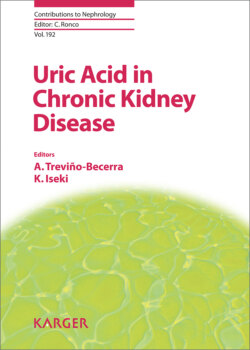Читать книгу Uric Acid in Chronic Kidney Disease - Группа авторов - Страница 27
На сайте Литреса книга снята с продажи.
Hyperuricemia and Renal Transplant
ОглавлениеIt has already been commented that uric acid is involved in endothelial dysfunction, proliferation of vascular smooth muscle, and stimulation of profibrotic and inflammatory cytokines. The evidence addressing the association between elevated uric acid with GFR decline in renal transplant recipients in whom hyperuricemia is highly prevalent is contradictory. While some studies did not document an association between the level of uric acid and the decline of GFR in KTR, there are others that report the association to range from a slight to a strong one. Cyclosporine is also known to raise the uric acid level, and we found that the renal disease induced by cyclosporine could be worsened by raising the uric acid level and lessened by lowering it [28].
In a review, Bellomo [29] summarized epidemiological and interventional studies that demonstrated the association between elevated uric acid level and its consequences on renal graft function. Concluding that randomized controlled trials of urate lowering therapy are badly needed in this population of patients, to establish whether preservation of renal function and prolongation of graft survival can be achieved.
Hart and et al. [30], identified the association between uric acid and the primary composite outcome of doubling of interstitium or ESRD from interstitial fibrosis and tubular atrophy, and also found that a 1 mg/dL increase in time-varying uric acid was associated with a 2.39 mL/min lower final GFR but not with the secondary outcome of creatinine doubling, ESRD, or death.
